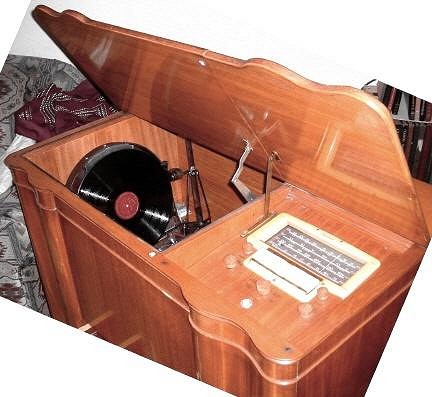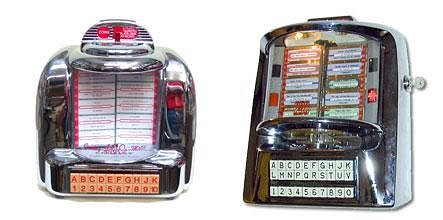Pages: 1 8 replies
|
STCB

Sabu The Coconut Boy
Posted
posted
on
Sun, Dec 27, 2009 1:34 AM
Nowadays you go into a tiki bar like Trader Vic's or Don The Beachcomber and if you're lucky, there will be some nice ambient Exotica music playing on the CD system. In other bars, like the Purple Orchid and the Kona Club, a CD jukebox will offer a variety of vintage music like Surf and 50's Rock and Swing which creates a different mood, but still reinforces that feeling of escapism to a different era. But what did they do in the days before CD players? Well, we know that a lot of tiki restaurants had live music. We know this from record albums recorded Live at these restaurants and ads in weekly entertainment publications, like "The Playgoer", in major cities that listed the bands and singers and small combos playing at restaurants like the Latitude 20 and the Hawaii Kai. Most of this music seemed to be Hawaiian or Hapa Haole in style, but since dancing was an integral part of the dining experience, I bet these Hawaiian bands played a lot of standard dance music too. Postcards show that most of these Polynesian Restaurants had dance floors as well as stages for the musicians. Dancing was popular when South Seas bars started in the 30s, and was still popular in the tiki restaurants of the 60s. The house band at the Hawaiian Room in New York's Emerson Hotel even re-wrote classic Hawaiian melodies to give them a dance beat so that you could fox-trot or swing to them. The larger restaurants even had Hawaiian Floor Shows, with hula dancers and all. But what happened when the musicians weren't playing? And what about the smaller bars and restaurants that didn't have live acts? Was background music as important back in the old days as it is today? If it was, how did they accomplish it? Going through the old ads from these restaurants, you occasionally catch a reference to "Hawaiian records" being played for atmosphere. But frankly, this seemed like a pain in the neck to me. Did they have an employee assigned to flip the records when they were done? I know what a chore it can be for me to get up to flip records during a dinner party at my house. That must have been a tiresome task all night long at a tiki bar. Then I recently read a four-page review of Don The Beachcomber in Hollywood, written in 1943. It gave a lot of the small, intimate details of the restaurant, including this passage: "There is no orchestra at The Beachcomber, and no floor show. Only a dignified Capehart, playing subdued South Pacific melodies." This was fascinating, but I had no idea what a Capehart was. So I looked it up on the internet and this is what I discovered: The Capehart was the ultimate in luxury record players of the time. It was an amazing piece of techno-gadgetry mounted in an elegant wooden cabinet.
"The fabulous Capehart Deluxe home radio-phonographs of the 1930s and 1940s. These instruments used a wonderful record changer designed by Ralph Erbe, and this changer was unequalled for features in its time. In addition to being able to play 10" and 12" records intermixed, this ingenious changer would also turn each record over. It could turn each record over immediately, so that the B side could be played following the A side, or it could turn the record over as it returned it to the stack, thereby placing it in position to play the opposite side the next time the record came through the stack." It could store sixteen 78rpm records and play all 32 sides before it stopped. It was, in effect, the CD-player of its day. If you go to this Website you can even watch a short movie of the flipping mechanism in action. So when you realize that Don's had exotic Hawaiian records playing in the background, mixed with their periodic manufactured rainstorms that were so realistic that first-time patrons often ran outside to roll-up their car windows, you can tell that this restaurant, at least, took their dining and drinking atmosphere very seriously. I'm betting other restaurants of the time had similar Capehart systems, but I'd be interested to find out how the background music was handled during the 50s and 60s. Did any of these tiki bars switch to jukeboxes when they became available or did they just upgrade to more modern multi-record-players? Let me know your thoughts and discoveries.
[ Edited by: Sabu The Coconut Boy 2013-05-03 18:15 ] |
|
UT
uncle trav
Posted
posted
on
Sun, Dec 27, 2009 5:47 AM
Great subject for a thread Sabu and some fine research also. I'm thinking that reel to reel tape may have been an option for many bars and restaurants. A relatively small and easy to use piece of equipment for the time to buy and use. Reel to reel also sounded great and many exotica acts at the time had tapes out at the same time the albums were released. In the end I would think that Muzak had a hand in the downfall of the classic dining experience as well. Just my opinion though. |
|
TM
tiki mick
Posted
posted
on
Sun, Dec 27, 2009 9:10 AM
Sabu, I love this thread, because it confirms something I already know: The sound track of the original tiki bar was a hapa haole band. One probably much like these guys: http://www.myspace.com/thesmokinmenehunes I would invite you to come down to one of our free performances coming up, and see for yourself. We have tried our best to recreate the original tiki scene that you are talking about in this thread. In between our sets, we do use a CD player but the songs we play are also classic instrumental hawaiian tunes. Here are some modern samples of stack-o-matic turntables. I believe Crosley also has a larger, console type as well. Of course, these are lacking the tube technology that gives old records that "sound", but it's the next best thing. I own one. http://www.crosleyradio.com/Product.aspx?pid=1593 [ Edited by: lucas vigor 2009-12-27 09:14 ] |
|
T
tikiyaki
Posted
posted
on
Sun, Dec 27, 2009 11:14 AM
Interesting thread...Sabu. I know La Mariana in Honolulu has a piano player, and I'm pretty sure it always has....piano players in restaurants was a very popular thing in those days. My guess is that in alot of these places between sets of music, there was just NO music....maybe to give diners a break to chat. Even more so if there was a combo playing, and it was even more of a "show" as opposed to background music. It certainly is a good question. That capeheart device is crazy. Last year when Tikiyaki PLayed a private show at the Beachcomber for the opening of Malibu pier, I was speaking to an older woman who told me that she used to go to the LUAU all the time in Beverly Hills, because it was one of the few places that had dancing...so,yea, dancing was indeed a big part of the equation. Can't imagine what dancing would have been like after those cocktails tho'. :o |
|
B
bigbrotiki
Posted
posted
on
Sun, Dec 27, 2009 1:31 PM
Thank you, Sabu, the discovery of Don's Capehart player conclusively solves the questions that came up in my CD thread:
|
|
M
MadDogMike
Posted
posted
on
Sun, Dec 27, 2009 3:07 PM
When I was a teen in the 70s, I worked at "El Tiki". It really wasn't tiki bar in the classical sense, but a Mexican restaurant cleverly disguised as a tiki bar - lots of tikis, blowfish, bamboo, thatched roofs over the tables, etc. They had the little individual chrome jukeboxes on each table but I have no idea what was on the playlist, probably top 40 and Mariachi music :) |
|
B
bigbrotiki
Posted
posted
on
Mon, Dec 28, 2009 8:28 AM
I believe you are talking about the Seeburg Wall-o-matic remote selectors :D ?:
|
|
M
MadDogMike
Posted
posted
on
Mon, Dec 28, 2009 8:57 AM
Yep. It's been 30+ years, but as I remembered they looked like the ones on the left. "Remote Selector" - so they weren't little jukeboxes, they just fed request into a big jukebox somewhere. I guess that makes sense. |
|
T
tikiyaki
Posted
posted
on
Mon, Dec 28, 2009 9:59 AM
Astro Burger in West Hollywood has those still. Very cool. |
Pages: 1 8 replies



